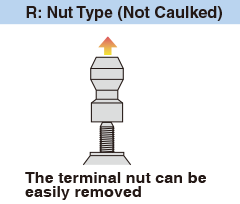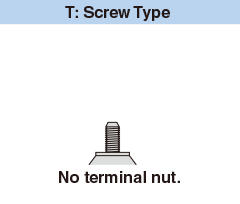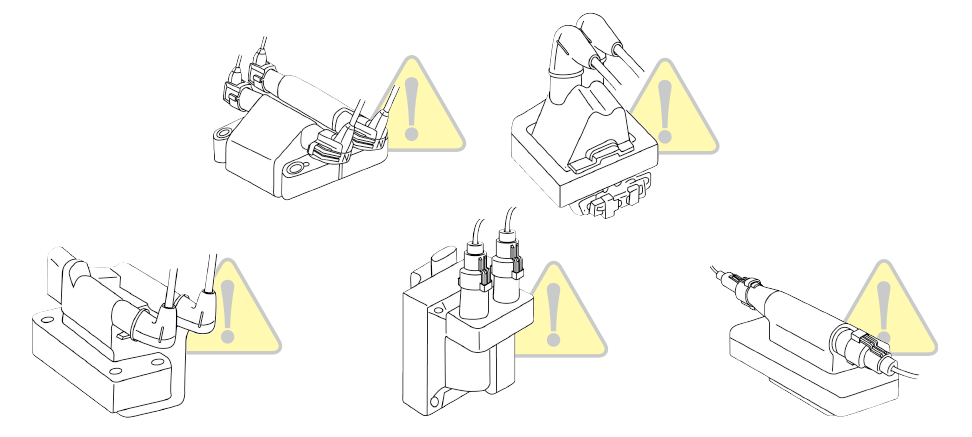WARNINGS and PRECAUTIONS (Please be sure to read)
Warnings and Precautions Regarding Safety and Usage
Be Sure to Read Through These Warnings and Precautions
IN NO EVENT SHALL DENSO BE LIABLE FOR ANY LOSSES, EXPENSES OR DAMAGES WHATSOEVER RESULTING FROM ANY OF THE FOLLOWINGS;
- FAILURE TO COMPLY WITH THE WARNING OR PRECAUTIONS DESCRIBED IN THIS CATALOGUE AND WEBSITE,
- ANY USES OTHER THAN THE APPLICABLE USE DESCRIBED IN THIS CATALOGUE AND WEBSITE, and
- ANY TROUBLE NOT ATTRIBUTABLE TO DENSO SPARK PLUGS.
*”Spark plugs” means any type of DENSO’s spark plugs, including but not limited to Iridium Power, Iridium TT, Iridium Racing, Iridium Plus, Iridium Saver, Iridium Tough, Iridium Long Life, Double Platinum, U-Groove, Resistor, Standard, Nickel TT, Platinum TT, Two-Tops.
WARNING (Prohibited Usage)
Be sure to turn off the engine and disconnect the battery or power source before replacing or adjusting the plugs. Failure to heed this warning may result in a fire, an electric shock and/or bodily harm.
- Never use DENSO spark plugs in the engines for any aircraft, including airplanes, helicopters, gliders and drones. The DENSO spark plugs sold are not designed and manufactured for any aircraft: use may result in a plane crash or other accidents due to engine malfunction.

- Never use DENSO spark plugs, listed in this catalogue or website, in the engines for generator and gas heat pump air conditioning system or co-generation, except DENSO spark plugs specially designed for such use. The DENSO spark plugs we sell are not designed and manufactured for such use, so that such use may result in accidents, including power generation stop or heat generation stop.
A separate catalogue for DENSO spark plugs specifically designed for co-generation is available for limited regions. Please contact your DENSO representative for more information. - Never use DENSO spark plugs for gas burner ignition. The DENSO spark plugs we sell are not designed and manufactured for such use, so that such use may result in ignition failure or equipment damage due to overheating.
- Use genuine spark plugs for special applications such as ambulances, police cars, emergency vehicles, and others.
Spark Plug Handling Precautions
Precautions for Tuning and Modified Vehicles
- DENSO will not bear any responsibility whatsoever for any trouble arising from mechanically or electronically modified engines or vehicles.
- It is the user’s judgement and responsibility to check the specifications required for modified engines or any engines or vehicles those are not listed in DENSO spark plugs catalogue and website, which includes and not limited to, gapping, heat ranges, reach, projection, and/or clearances with valves and/or pistons.
- Carefully read the instructions and precautions on the package, catalogue and website.
- Do not drop spark plugs. This may cause the spark plug to crack internally or the gap to be narrowed, preventing it from functioning correctly.
Catalogue & Website Precautions
- Precautions for cross reference and product tables listing other manufacturer’s spark plugs:
- Use for reference only. Table does not guarantee the performance of spark plugs when installed in the vehicles even plug was specified in cross references. Always check the applications section for DENSO recommended spark plugs.
- The spark plug specifications (construction, material, etc.) differ by manufacturers.
- Select a suitable type of spark plug from the vehicle application table. If not listed on the table, please check with your regional DENSO Representative.
- The contents of the catalogue and website are updated on a regular basis, however, the information and data may change after updating or publishing. Please note that this catalogue and website does not include models that will be release after last updating or publishing.
- Consumption tax and installation fees are not included in the price of the product.
- Some spark plugs on this catalogue and website are manufacturer’s genuine parts and reference only. Those cannot be sold directly from DENSO. Please contact your regional DENSO representative for further assistance.
- The appearance and specifications of the product are subject to change without prior notice.
- The images of spark plugs indicated in the catalogue and website are conceptual diagrams, and sometimes differ from the actual products.
- Data given in this catalogue are those as of October 2022. The information and data may change after updating or publishing. Please note that this catalogue does not include models that will be release after that.
Precautions for Selecting Spark Plugs
Select appropriate spark plugs with the correct dimensions and heat range by checking vehicle manual, maintenance manual and this catalogue’s or websites’ application table.
Spark Plug Selection Know-How
Normal Vehicle
- Use standard heat range plugs. However, if you often drive at low speeds or short distances and the carbon fouling recurs, you might able to avoid carbon fouling recurs by selecting a low heat range spark plug.
- Do not use a non-register type spark plug for a model specified a register type spark plug (spark plug with resistance). Noise associated by spark discharge may cause engine trouble.
- If the extended type spark plugs (J, QJ, KJ, PKJ, SKJ, VKJ, TJ, etc.) are installed to any other designated engine, it will interfere with valves and pistons and may damage the engine and plug.
Tuning or Modified Vehicle
- If the engine is modified, or if the tuning or modified vehicle uses an aftermarket muffler, ignition coil, plug cord, turbo installation, electronic ignition system, NOS ( * ), etc., the heat range of the spark plug must be increased according to the level of tuning. If the spark plug is not selected correctly, the vehicle may be damaged by carbon fouling, oil fouling or pre-ignition (the natural phenomenon of spontaneous combustion occurring faster than spark plug ignition), etc.
( * ) NOS: a device that increases engine power by injecting nitrous oxide with gasoline into the air intake - Select the heat range at your own discretion and responsibility when using the spark plugs in a tuning or modified vehicle.
When Using Iridium Racing Plugs
- Iridium Racing plugs are intended for racing and also for tuning up. Select the heat range of the spark plugs according to the tuning level, based on the heat range of the standard spark plugs or Iridium Power plugs.
- Generally, a plug that protrudes into the combustion chamber has superior ignition performance, resulting in improved engine performance. On the other hand, this type of plug is more susceptible to exposure to hot combustion gases and the longer ground electrode makes it less heat-resistant and durable. Therefore, the higher the level of tuning, the greater the need to use a type with recessed electrodes.
- Generally, the higher the level of tuning, the greater the need for high-heat range spark plugs.
- Use of Iridium Racing plug is at your own discretion and responsibility.
Select the Optimum Heat Range

Use of Spark Plug with Terminal Nut
Using a spark plug with a terminal nut with the terminal nut loose may cause engine malfunction. When using a spark plug with a part number marked “R” alongside “Terminal Shape” or “NUT” and a terminal nut attached, securely tighten the nut by using pliers or the like. For spark plugs with part numbers marked “RC” alongside “Terminal Shape” or “NUT,” the terminal nut is caulked and does not loosen under normal use. However, it may loosen in rare occasions when the engine and or plug cord vibrates intensely. If such a situation is expected, inspect the nut regularly and if it is loose, tighten it again securely.




Precautions for Installing Spark Plugs
It is necessary to install the plugs in the engine using the correct torque.
- Too low torque: may cause damage to the engine and the plugs due to leakage of combustion gas or vibration.
- Too high torque: may cause airtight leakage or break of the mounting screws due to the the caulking of the insulator and housing become loosened.
Recommended Torque and Tightening Angle
| Thread Size | Applicable Models | Recommended Torque |
Recommended Tightening Angle | |
|---|---|---|---|---|
| New Plug | Previously Used | |||
| M 8 | All Types | 8-10N・m | About 1/3 turn | About 1/12 turn |
| M10 | Types other than the ones shown below | 10-15N・m | About 1/3 turn | About 1/12 turn |
| M10 | UFE, IUH, VUH, VNH Types | 10-15N・m | About 2/3 turn | About 1/12 turn |
| M10 | Stainless Gasket Type ( *1VUH27ES,U24FER9S )
|
10-15N・m | About 3/4 turn | About 1/12 turn |
| M12 | All Types | 15-20N・m | About 1/3 turn | About 1/12 turn |
| M14 | Types other than the ones shown below | 20-30N・m | About 1/2 turn | About 1/12 turn |
| M14 | Stainless Gasket Type ( *2IK16G,IK20G,IK22G,K20PR-U8S, )
K20PR-U9S,KJ20DR-M11S,PK22PR-L11S, SK20PR-N9S,SK22PR-M11S,SKJ20DR-M11S, VK16G,VK20G,VK22G |
20-30N・m | About 2/3 turn | About 1/12 turn |
| M18 | All Types | 30-40N・m | About 1/4 turn | About 1/12 turn |
| M14 Taper seat |
All Types | 10-20N・m | About 1/16 turn | About 1/16 turn |
| M14 (Gas) |
If the cylinder head material is cast iron | 20N・m | – | – |
| M14 (Gas) |
If the cylinder head material is aluminum | 17.5N・m | – | – |
| M18 (Gas) |
If the cylinder head material is cast iron | 30N・m | – | – |
- (*1)VUH27ES, U24FER9S
- (*2)IK16G, IK20G, IK22G, K20PR-U8S, K20PR-U9S, KJ20DR-M11S, PK22PR-L11S, SK20PR-N9S, SK22PR-M11S, SKJ20DR-M11S, VK16G, VK20G, VK22G
Spark Plugs Installation
Caution
- Always refer to the vehicle manufacturer’s repair manual for specific installation procedures.
- Do not apply screw thread lubricant to the spark plug since it may make you over tighten the spark plug and cause the screw to break.
However, screw thread lubricant is already applied to some plugs for LPG engines. In such case, tighten the plug according to the maintenance manual.
- Check the gasket ring.
Caution
When cleaning the mounting seat on the engine side, be sure that oil, dust and foreign objects in the vicinity of the cylinder head to not fall into the engine.
- Hold the spark plug vertically to plug hole and lightly tighten it by hand or by using a plug wrench.


Caution
Use plug wrench that fits to the plug’s hexagonal housing
- Using a plug wrench, tighten the plug to the recommended torque or the recommended tightening angle.

Caution
Be careful not to hold the wrench obliquely.

Caution
Tighten the plug to the recommended torque or the recommended tightening angle.

Insulator Cracking
The spark plugs of recent engines are installed in deep plug holes, and it is difficult to notice the tilted wrench when installing and removing the spark plugs. However, if you turn the wrench in this condition, the head of the insulator may become stuck. By applying excessive force, resulting in cracking.
*The mode of occurrence differs depending on the difference in the structure and the dimensions of the plug hole by vehicle and the type of wrench.


The spark plugs of recent engines are installed in deep plug holes, and it is difficult to notice the tilted wrench when installing and removing the spark plugs. However, if you turn the wrench in this condition, the head of the insulator may become stuck. By applying excessive force, resulting in cracking.
*The mode of occurrence differs depending on the difference in the structure and the dimensions of the plug hole by vehicle and the type of wrench.
Spark Plug Replacement Timing
The electrode progressively wears, causing the spark gap to increase, along with the increasing number of spark discharges. When the gap exceeds a certain limit, the sparking performance deteriorates, which may prevent stable ignition of the gas mixture. When this happens, the horsepower of the engine falls, the fuel economy deteriorates and also the quality of the exhaust gas is adversely affected, so it is necssary to replace the plugs.
The table below shows our recommended plug replacement timing as a rough guide to the economic life of the plugs. The economic life may be reduced depending upon the vehicle running condition and the sparking characteristics**.
| IRIDIUM POWER Ni-TT Plugs Conventional Spark Plugs | IRIDIUM TOUGH IRIDIUM PLUS Platinum Plugs | |
|---|---|---|
| Automobile | ~ 20,000km | ~ 100,000km* |
| Motorcycle | ~ 5,000km (No settings for Ni-TT Plugs) | No Settings |
*The small engine vehicle, a tuned vehicle or a vehicle that uses a simultaneous ignition coil is often used at high speed. This may cause the life of the plugs to be reduced.
**Factors which shorten life
- Running condition: High-speed driving, high-load driving, hill climbing, extended idling (taxi), etc.
- Ignition characteristics: Simultaneous ignition, positive discharge, use of high-energy coil, etc.
Simultaneous Ignition System
A simultaneous ignition system is an ignition system in which two plug cords are connected from one coil, as shown in the figure. Generally, a single coil provides high voltage to a single spark plug, and negative (-) discharge is used so that it reduces electrode wear and tear. Simultaneous ignition systems, on the other hand, a single coil provides voltage to two spark plugs, which are negative (-) and positive (+) discharge. It resulting the generation of waste fire that is not related to combustion, which causes electrode wear and tear, especially in positive (+) discharges.

Adjustment of the Plug Gap
- If the center electrode becomes rounded or the ground electrode wears unevenly, replace the spark plug with a new one.
- Do not adjust the gap of a spark plug that has a fine electrode, such as a platinum plug or an iridium plug. It may result in damage of the center electrode.
